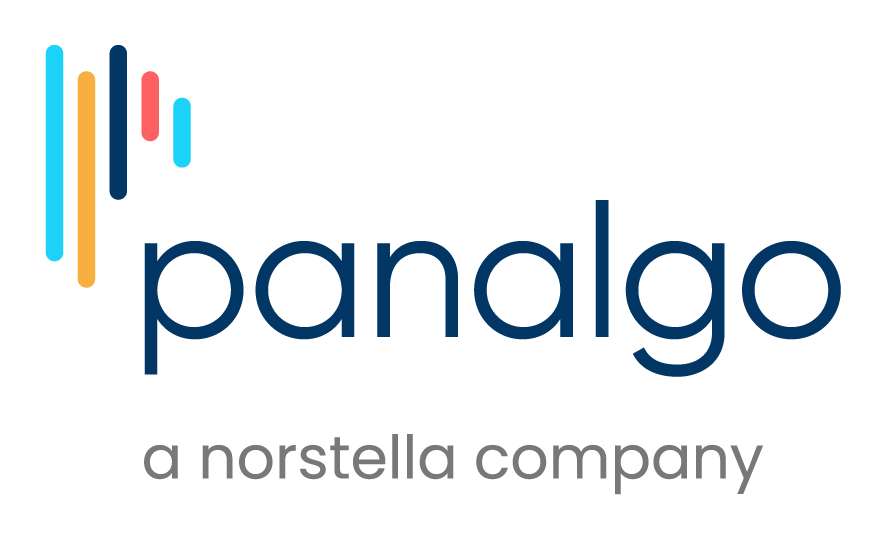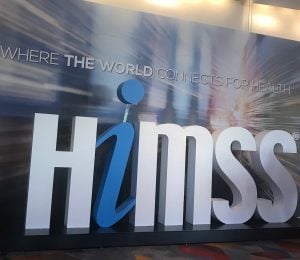
Healthcare IT's March Madness: A Recap of HIMSS18
Although the NCAA’s March Madness is just heating up, my own March madness is starting to wind down. For those of us in New England, March’s madness really kicked off with three wild Nor’easters. Fortunately for me, these storms coincided with trips to Las Vegas for the Healthcare Information and Management Systems Society (HIMSS)’s Annual Conference and to Philadelphia for BHE’s Instant Health Data (IHD) User Conference. Now that the dust, or should I say snow, is settling I’m excited to look over and share some of the great insights I learned from HIMSS18.
Who attended HIMSS18?
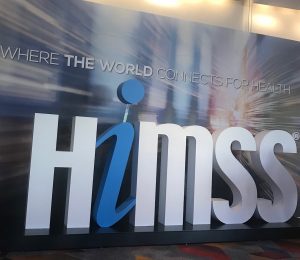 If you aren’t familiar with the HIMSS conference, it attracts roughly 45K professionals from across the world for educational sessions and networking opportunities focused on health information and technology. This year the conference boasted a total of 43,979 attendees, including over 1,300 healthcare IT vendors. That’s a lot of people in one place so it’s not surprising that attendees have started describing it as HIMSSanity. The attendee specifics aren’t yet available on this year’s conference, however, a majority of HIMSS17 attendees were from healthcare provider organizations (~47%), roughly four percent were from payer organizations and three percent were from life sciences organizations.
If you aren’t familiar with the HIMSS conference, it attracts roughly 45K professionals from across the world for educational sessions and networking opportunities focused on health information and technology. This year the conference boasted a total of 43,979 attendees, including over 1,300 healthcare IT vendors. That’s a lot of people in one place so it’s not surprising that attendees have started describing it as HIMSSanity. The attendee specifics aren’t yet available on this year’s conference, however, a majority of HIMSS17 attendees were from healthcare provider organizations (~47%), roughly four percent were from payer organizations and three percent were from life sciences organizations.
What were the key themes at HIMSS18?
From the opening keynote by former Alphabet executive Eric Schmidt to walking around the exhibit hall, you couldn’t miss that machine learning (ML) and artificial intelligence (AI) were hot topics. As with past years, interoperability, FHIR, and HL7 continue to be explored, although the focus has shifted from how do healthcare organizations connect disparate systems using FHIR and HL7 to how can these same organizations drive value in healthcare from integrated data. Precision medicine was also a pretty popular topic and blockchain had a fair bit of attention as well.
HIMSS Sessions with RWE Implications:
With the variety of session options at HIMSS, I decided to focus on those that overlapped with data analytics, real-world evidence (RWE), and life science research. These included sessions on Health Information Exchanges (HIEs), value-based contracting, precision medicine, data analytics, and blockchain. Below are some key highlights from four of these sessions:
Technology for a Healthier Future: Modernization, Machine Learning, and Moonshots – Eric Schmidt, Alphabet, Inc.
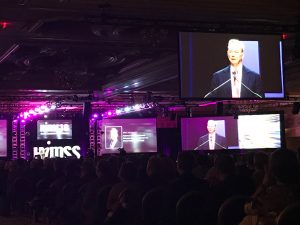 During Eric Schmidt’s talk, what left an impression on me was that the massive amounts of data generated through EHR encounters, through wearables, etc. have so much potential for use in RWE research. I wondered how pharma and medical device companies could also contribute their data to move predictive analytics forward? Additional takeaways to note from Eric Schmidt’s keynote are:
During Eric Schmidt’s talk, what left an impression on me was that the massive amounts of data generated through EHR encounters, through wearables, etc. have so much potential for use in RWE research. I wondered how pharma and medical device companies could also contribute their data to move predictive analytics forward? Additional takeaways to note from Eric Schmidt’s keynote are:
- If you are in healthcare and work with data, “Run to the cloud.” The cloud is the only scalable way to handle the volume of healthcare data generated today.
- Healthcare needs a new approach to running experiments with a clinical data warehouse that hosts all the data sources as one.
- It’s easy to classify data, but what healthcare needs is prediction, specifically predictive analytics.
- Healthcare is becoming an information science, but it lacks a “killer” app that achieves more than workflow efficiencies.
HIE Data: The Value Proposition for Payers and Providers – Laura McCray, KHIN, Tara Orear, Newman Regional Health, Dirk Rittenhouse, Anthem.
 HIEs have come a long way in the last five years and it was exciting to hear that the focus is shifting to using the connected clinical information to drive improved patient outcomes. Similar to Eric Schmidt’s talk, I wondered how life science researchers could collaborate with HIEs to analyze and develop more efficient and effective clinical trials, as well as treatments. Since I am new to the life sciences space, I am curious to learn if life sciences researchers find the data in the CCDs to be useful in the RWE research.
HIEs have come a long way in the last five years and it was exciting to hear that the focus is shifting to using the connected clinical information to drive improved patient outcomes. Similar to Eric Schmidt’s talk, I wondered how life science researchers could collaborate with HIEs to analyze and develop more efficient and effective clinical trials, as well as treatments. Since I am new to the life sciences space, I am curious to learn if life sciences researchers find the data in the CCDs to be useful in the RWE research.
Highlights from this panel included:
- From an HIE perspective, none of the payers want the same thing. An HIE must be flexible with payers as well as providers.
- For years, HIEs focused on interoperability. Now HIEs are focused on getting complete, accurate data into the HIE, specifically complete and correct CCDs (Consolidated Clinical Document).
- From a payer perspective, there are common threads across HIEs:
- Payers are looking for incremental and additive data.
- HIEs have mostly encounter-based data, so it requires detective work to decipher the bigger picture for the patient.
- Payers have their own HIE platforms that they bring clinical and claims data into.
- Anticipate that clinical data will be part of their value-based contracts
Precision Medicine: Separating Hype from Reality – Paul Cerrato, Medscape, John Halamka, Beth Israel Deaconess System
 This session was a bit more high-level of a session than I had hoped, but I still found the session interesting and was pleased to hear John Halamka’s say he is optimistic that we are moving towards precision medicine, not just personalized medicine. Additional points made were:
This session was a bit more high-level of a session than I had hoped, but I still found the session interesting and was pleased to hear John Halamka’s say he is optimistic that we are moving towards precision medicine, not just personalized medicine. Additional points made were:
- The main arguments against precision medicine are:
- Costs are too high.
- Physicians are already practicing precision medicine.
- No “real-world” clinical benefits.
- Lack of interoperability.
- Personalized medicine and precision medicine are not the same thing:
- Traditional personalized medicine is really trial-and-error medicine.
- Precision medicine should be able to predict what will happen to you over time.
- Blockchain will be the hot topic for HIMSS19.
The Use of Blockchain to Improve Quality Outcomes – Jason Goldwater, CedarBridge Group, LLC
This session was quite informative. Not being a data person myself, I still am a little uncertain how blockchain can be applied to healthcare, and specifically, if there will be implications for the life sciences industry. Key points included:
- A Blockchain is a way to structure data through a sequence of blocks which hold a complete list of transaction records. A blockchain is the way you take data in and move it.
- Disadvantages are that the large amounts of data can lead to slow processes and there is no guarantee of transactional privacy.
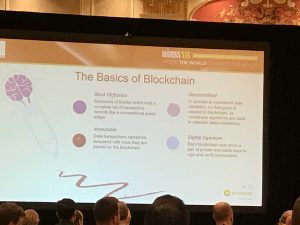
Blockchains are not new but one block chain can hold a lot of data so many think it can solve interoperability.
- Blockchain development is in the innovation stage so it is uncertain as to which use cases blockchain will be successful at solving.
- Hype is spurring innovation and creation of more blockchains, but without a set of standards, it will be hard to solve interoperability.
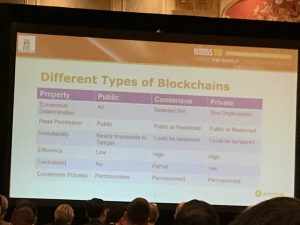
What about Pharma at HIMSS18?
Traditionally the HIMSS organization is a provider-focused group, so most of the HIMSS18 sessions were on provider-based topics. However, with the emphasis on connecting data across the entire healthcare system increasing, HIMSS seems to be expanding its topics to include additional healthcare organizations such as payers and life sciences organizations. I did notice an increase in payer involvement in the education sessions this year compared to the last HIMSS I attended in 2015. I have also heard that pharmaceutical engagement is on HIMSS’s radar, so it will be interesting to see if there will be more life sciences inclusion at future HIMSS conferences. I am curious to see how many attendees were from life science organizations at this year's event. Either way, with the focus on health information and technology, the HIMSS conference does provide valuable learning, and networking opportunities for anyone in the healthcare industry.
